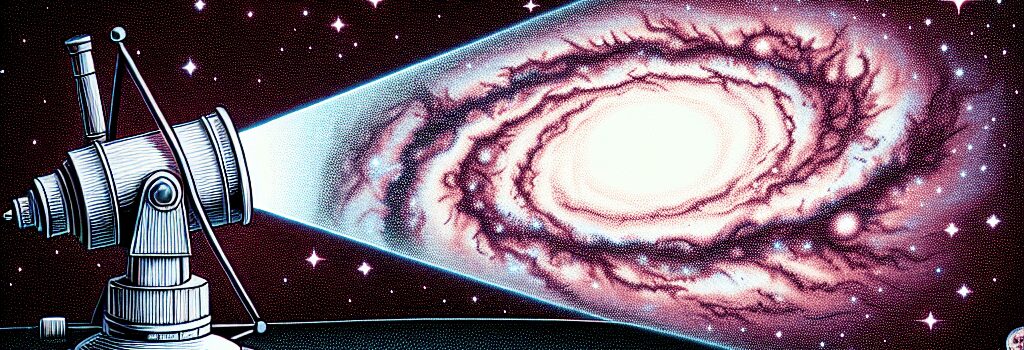Tuesday Telescope: Unveiling the Milky Way’s Hidden Dimensions Through Radio and Infrared Eyes

The Milky Way has long been a canvas for observational wonder. Today, an image captured by South Africa’s MeerKAT radio telescope array offers a breathtaking context to the James Webb Space Telescope’s detailed infrared view of the Sagittarius C region. This innovative juxtaposition not only enriches our visualization of the galaxy’s center but also hints at the majestic interplay between well-established radio astronomy and groundbreaking infrared imaging.
The Legacy of Powers of 10 and Its Enduring Influence
Many of us remember the classic Powers of 10 film from the 1970s—a mesmerizing journey from the macroscopic scales of the universe to the subatomic realm. Created by the innovative minds at the Eames Office—also known for the Eames Lounge Chair—the film instilled a deep appreciation for scale and design among viewers of all ages. This piece of pop culture, which masterfully combined art with science, now echoes in the layered details of today’s astronomical images.
MeerKAT: Technical Mastery of Radio Astronomy
The primary image, taken by MeerKAT, showcases the Milky Way’s center with impressive clarity. Comprised of 64 high-precision dish antennas, MeerKAT operates over a frequency range from approximately 580 MHz to 14 GHz. This array captures the intricate vertical filaments and supernova remnants with high sensitivity, revealing ghostly, bubble-like structures that have persisted from ancient, cataclysmic events. The telescope’s design allows for deep integration times and high-resolution imaging, providing astronomers with a detailed view of interstellar gas dynamics and magnetic field lines near the supermassive black hole at the galaxy’s core.
Sagittarius C: A Region Alive with Star Formation
On the right side of the composite image is an infrared view from the James Webb Space Telescope of the Sagittarius C region—an area bustling with stellar activity. This zoomed-in perspective unveils an estimated 500,000 stars, set against a backdrop of ionized hydrogen that is depicted in a striking cyan hue. The infrared data, which penetrates dense clouds of dust and gas, reveals needle-like structures within the ionized regions. While their precise origin remains a subject of investigation, preliminary expert analyses suggest these features could be the result of shock fronts from stellar winds or localized magnetic field disturbances.
Deep Dive: Technical Analysis and Instrument Synergy
- Data Integration: Scientists are combining radio frequency and infrared imaging techniques to create multi-wavelength composite pictures. This synergy allows a more comprehensive mapping of cosmic phenomena, from high-energy particle acceleration zones to regions of cool, dense star formation.
- Computational Advances: The processing of massive datasets from MeerKAT and James Webb is aided by cutting-edge AI algorithms and machine learning models refined for image reconstruction and noise reduction. These technologies enable astronomers to filter out interference and extract subtle features that were previously indiscernible.
- Calibration and Resolution: With digital interferometry, MeerKAT achieves arcsecond-level resolution, vital for tracking the faint filamentary structures near the central black hole. Similarly, JWST’s near and mid-infrared capabilities are producing unprecedented clarity in high-density star-forming regions.
Expert Perspectives and Future Research
Leading astrophysicists and engineers, including contributors like John Bally and Ruben Fedriani, have expressed excitement about the potential of these synergistic observations. Experts note that the needle-like structures observed in the Sagittarius C region may hint at complex interactions between ionized gas and magnetic fields—phenomena that could revise current models of star formation.
Moreover, the advanced design of MeerKAT, combined with the versatile imaging power of Webb, is paving the way for future large-scale surveys of the galaxy’s core. Upcoming projects, such as the Square Kilometre Array (SKA), are set to build on these findings, promising even higher fidelity imaging and deeper insights into the structure and evolution of our galaxy.
Implications for Astronomy and Beyond
The convergence of data from radio and infrared observatories not only enhances our understanding of the Milky Way but also exemplifies the benefits of integrating multi-spectral observations in astrophysics. These methods may soon be applied to studies of galaxies far beyond our own, as improved computational methods and sensor technologies continue to evolve.
As the field of astronomy embraces digital transformation—with AI-driven algorithms optimizing data processing and the development of more powerful arrays like SKA—the study of cosmic phenomena is entering a golden age. These advances provide a clearer picture of the universe, helping researchers bridge gaps in our knowledge about the origins of cosmic structures, the behavior of supermassive black holes, and the lifecycle of stars.
Credit: NASA, ESA, CSA, STScI, SARAO, Samuel Crowe (UVA), John Bally (CU), Ruben Fedriani (IAA-CSIC), Ian Heywood (Oxford)
Stay tuned for further updates as new data and insights continue to emerge from both MeerKAT and the James Webb Space Telescope—a testament to the collaborative spirit and technological innovation driving modern astronomy.